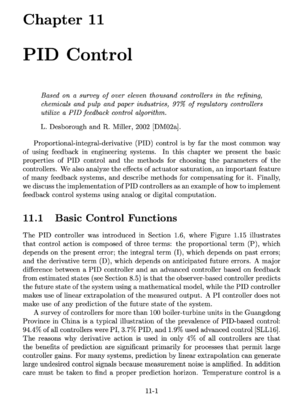Difference between revisions of "PID Control"
Jump to navigation
Jump to search
| (3 intermediate revisions by the same user not shown) | |||
| Line 1: | Line 1: | ||
{{Chapter | {{Chapter | ||
|Chapter number=11 | |Chapter number=11 | ||
| + | |Short name=pid | ||
|Previous chapter=Frequency Domain Analysis | |Previous chapter=Frequency Domain Analysis | ||
|Next chapter=Frequency Domain Design | |Next chapter=Frequency Domain Design | ||
| + | |First edition URL=https://www.cds.caltech.edu/~murray/amwiki/index.php?title=PID_Control#Frequently_Asked_Questions | ||
| + | |Chapter summary=Proportional-integral-derivative (PID) control is by far the most common way of using feedback in engineering systems. In this chapter we present the basic properties of PID control and the methods for choosing the parameters of the controllers. We also analyze the effects of actuator saturation, an important feature of many feedback systems, and describe methods for compensating for it. Finally, we discuss the implementation of PID controllers as an example of how to implement feedback control systems using analog or digital computation. | ||
|Chapter contents=# Basic Control Functions | |Chapter contents=# Basic Control Functions | ||
# Simple Controllers for Complex Systems | # Simple Controllers for Complex Systems | ||
Latest revision as of 21:35, 28 August 2021
| Prev: Frequency Domain Analysis | Chapter 11 - PID Control | Next: Frequency Domain Design |
Proportional-integral-derivative (PID) control is by far the most common way of using feedback in engineering systems. In this chapter we present the basic properties of PID control and the methods for choosing the parameters of the controllers. We also analyze the effects of actuator saturation, an important feature of many feedback systems, and describe methods for compensating for it. Finally, we discuss the implementation of PID controllers as an example of how to implement feedback control systems using analog or digital computation.
